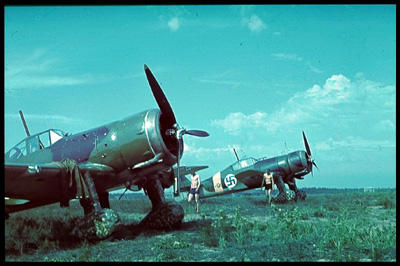


War in the air formed an essential part of the large-scale operations in the Second World War, and was aimed at the destruction of the war material of the opponent, whereas in the First World War operations in the air had only distracted the actions of the adversary.
The range of the aircraft enabled the attackers to penetrate deep into the rear of the enemy. To make the warfare more effective, aeroplanes flew in formations of hundreds of planes. That is why operations were also more and more directed towards the civilian population. The war became total. The entire population of a state was involved in the war, both actively and passively.
At the beginning of the war the target bombardments of the German diving bombers (Stuka) aroused great attention, but in the course of the war horizontal bombing proved more effective. The strategic bombardments of Germany (the American "flying fortresses" in the daytime and the English at night) were the largest bombing operations of the Western Powers towards the end of the war. Land battle or storm machines (Russian sturmovik) were used to diminish the power of the tanks, and torpedoes to disturb the operations of war fleets. The offensive and defensive battles of the fighters formed an important part of this war, and the most successful "aces" managed to drop 50-100, some even 200-300 enemy planes.
Guerre d'Hiver | Grand Quartier Général | Ligne Mannerheim | Guerre de Continuation | Risto Ryti | Ordre du jour de l'épée au fourreau | Schnaps de Marski | Croix Mannerheim | Dignité de Maréchal de Finlande | Combats aériens des guerres d'Hiver et de Continuation | Grande offensive de l'isthme de Carélie | Grande offensive de l'Olonets
ELEMENTS PERSONNELS | FAMILLE | ADOLESCENCE
| CARRIERE MILITAIRE
GUERRE D´INDEPENDANCE | REGENT | ACTIVITES
CIVILES | CONSEIL DU DEFENSE
COMMANDANT EN CHEF | PRESIDENT
DE LA REPUBLIQUE | ANNEES DE LA RETRAITE
THEMES PARTICULIERS









